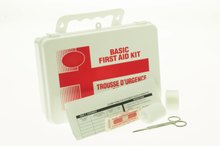How to Clean Enema Bags With Peroxide
An enema bag and tubing set is used to hold fluid and deliver it into the rectum and large intestine for cleansing for the treatment of constipation. If bacteria or mold are allowed to grow in the enema set, they can inadvertently enter the rectum and grow on the intestinal wall or, more seriously, find their way into the small, fragile blood vessels that supply the rectal and intestinal tissues. The enema set is usually made of rubber, and since prolonged exposure to bleach can damage it, washing the set with soap and rinsing it with hydrogen peroxide is advisable.
Disassemble the enema set if possible. After using the enema set remove the tubing from the bag and the tip from the tubing. Wipe any visible matter from the outside of the tubing and tip with toilet paper.
How to Use Bleach to Disinfect Toothbrushes
Learn More
Wash each part of the enema set, one at a time with a solution of antibacterial soap and water. This will remove bacteria and parasites that were in the rectum or stool from the set. Begin with the bag itself because it is the cleanest part. Turn the bag inside out to wash it. Rinse with warm water. Do the same with the tubing and tip, running the soap solution through the inside and washing the outside manually before rinsing well. Finish by washing your own hands and drying.
Reconnect the enema set pieces. Pour two cups of undiluted 3 percent hydrogen peroxide into the enema bag and let it flow through to the tip then clamp it off. Fold the top of the bag over on itself and invert several times to moisten all the bag's internal surfaces well. Hydrogen peroxide's effectiveness in disinfecting inanimate surfaces against bacteria, viruses, parasites and molds depends on its concentration and the length of time the hydrogen peroxide solution is in contact with the surface. The U.S. Food and Drug Administration approves solutions of 3 percent for sale to consumers and, according to the Centers for Disease Control and Prevention, a 3 percent solution requires 2 1/2 hours of contact to disinfect against all pathogenic or disease causing agents, with shorter times leaving many dangerous bacteria alive and able to reproduce. To insure this level of disinfection, leave the bag and tubing filled with the solution for 2 1/2 hours before emptying the solution into the toilet. You can also leave it filled all day or overnight without any harm.
How to Clean Clear Retainers
Learn More
Rinse the bag and tubing with running water to remove any remaining hydrogen peroxide. This is important because the residue has been linked to inflammation of the colon, according to an article in the October 2007 issue of "Endoscopy," which reports several cases of hydrogen peroxide-related colitis following colonoscopy 2. This finding by physicians at the Gemelli University Hospital in Rome, Italy serves as a warning about how susceptible the tissues of the rectum and intestinal wall are to foreign substances.
Air dry the inside of the enema bag and tubing with the clamp open for 8 hours. Do not place in the sunlight as this can destroy the rubber bag. Then place the dry enema set in a plastic storage bag large enough to hold all the contents and close the top of the bag before storage. It is important that all surfaces are thoroughly dry before storage or mold can grow. If necessary, use a hair dryer on low to speed up the drying process, aiming the nozzle into the top of the enema bag.
Warnings
The repetitive use of enemas and colon cleansing regimens is not considered safe or effective for the treatment of any illness and is not recommended. Consult with your physician before deciding whether the risks associated with enemas make this a safe practice for you.
Related Articles
References
- Centers for Disease Control and Prevention: Guideline for Disinfection and Sterilization in Healthcare Facilities, Hydrogen Peroxide: 2008
- "Endoscopy"; Hydrogen Peroxide-Related Colitis; G. Cammarota; October 2007
- Shariff MK, Sheikh K, Carroll NR, et al. Colorectal cancer detection: time to abandon barium enema? Frontline Gastroenterol. 2011;2(2):105-109. doi:10.1136/fg.2010.003616
- Lund JN, Buckley D, Bennett D, et al. A randomised trial of hospital versus home administered enemas for flexible sigmoidoscopy. BMJ. 1998;317(7167):1201. doi:10.1136/bmj.317.7167.1201
- Niv G, Grinberg T, Dickman R, Wasserberg N, Niv Y. Perforation and mortality after cleansing enema for acute constipation are not rare but are preventable. Int J Gen Med. 2013;6:323-8. doi:10.2147/IJGM.S44417
- Peate I. How to administer an enema. Nurs Stand. 2015;30(14):34-6. doi:10.7748/ns.30.14.34.s43
- Wickham RJ. Managing Constipation in Adults With Cancer. J Adv Pract Oncol. 2017;8(2):149-161.
- Galla, N.; Grinberg, T.; Dickman, R. et al. Perforation and mortality after cleansing enema for acute constipation are not rare but are preventable. Int J Gen Med. 2013;6:323-28. doi:10.2147/IJGM.S44417.
Resources
Writer Bio
Walli Carranza is a professor, author, Certified Professional Coach and national speaker who brings medical and educational discoveries to front-line providers and the public alike. Her writings include "Six Seasons of Optimal Wellness," "8 Realms of Life by Intention," "Zero Balance Day" and "Body ReCreation." Carranza holds a Doctor of Nursing from the University of Texas, Austin.









